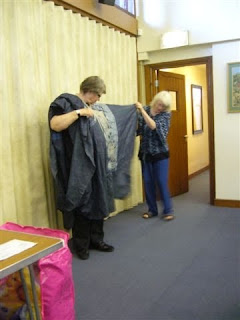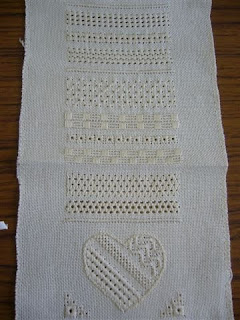Whilst we may have been blogless, we have not been idle. Here are reports from our meetings in February and April:
Quilts and beaded tasselsOur speaker in February, Elaine Peel, held us spellbound with the stories that are stitched into her quilts. She told us her quilts are well used, well washed and well loved and that each has lots of memories attached. She brought some of her quilts to show us, including the very first one she ever made, and spun her tales for us as she unfolded and displayed her work.
Elaine also buys old quilts, she buys them at markets, sales, etc, and she showed us three that she has rescued because, she says, “they need someone to love them and take care of them”.
Having once made a set of small tassels to decorate a quilt, she continued to experiment and devised her own methods of tassel-making. She realised that to make really decorative tassels she needed to learn how to bead, so she joined the Beadworkers’ Guild. Now Elaine teaches others how to make exquisite beaded tassels like the ones she brought to show us.
 Recycling fabrics, April 2010
Recycling fabrics, April 2010
How refreshing to hear a newly-qualified young embroiderer tell us how she treasures fabrics from years ago, how they are better quality than most sold today, and how she spends hours in charity shops and jumble sales seeking them out.
Amy Senogles, our speaker in May, has a BA in Embroidery. When writing her dissertation she explored the reasons for the vast increase in poorly made, inexpensive fashion items. She concluded that developments in mass production during WW2 aided the growth of the clothing industry, whilst a growing teenage market with disposable income and a desire to follow the latest trends increased the need for such clothing. She told us that it is estimated that, between 2002 and 2007, clothing purchases in Britain increased by a third. On average each Briton now buys more than 50 new items of clothing a year!
Amy showed us her degree portfolio, for which she constructed garment pieces from vintage textiles (tablecloths, tray cloths, etc) and new suiting cloth. Amy pieced the fabrics together, then extended the existing embroidery onto the new cloth, creating a completely new design and has sold some of these ideas commercially.

She suggested three obvious ways of recycling: selecting old fabrics for their pattern or colour and making them into something else, such as cushions and bags; making a new garment from several older ones; using scraps and offcuts for patchwork or to make accessories such as buttons and brooches.

Amy now works for Salford Heritage Services as a Merchandising Officer, buying and commissioning work for sale in shops at various heritage sites. She is also available to give talks to branches of the Embroiderers’ Guild and other organisations.
Next time: a report on our pulled thread workshop....























